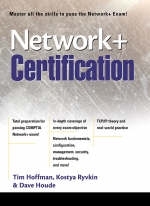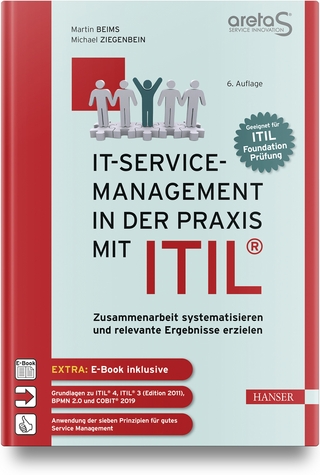
Network + Certification
Prentice Hall (Verlag)
978-0-13-016895-5 (ISBN)
- Titel ist leider vergriffen;
keine Neuauflage - Artikel merken
PLEASE PROVIDE
Designed for technicians with at least 18 months experience, the Computer Technology Industry Association's Network+ exam is the industry's #1 cross-platform networking certification. This in-depth, expert guide gives you all you need to prepare -- and pass your Network+ exam with flying colors! Start with the basics: what networking is, and how it works. Understand today's leading network operating systems, cabling, and connection schemes; then master the fundamentals of both LAN and WAN technologies. The book includes comprehensive TCP/IP coverage, covering configuration, management, and troubleshooting. Learn what you need to know about network administration, remote access, maintenance, troubleshooting, and more! Network+ Certification delivers complete, up-to-date coverage of every exam objective -- with sample A+ Q&As and "study break" reinforcement sections in every chapter. For all computer technicians and support professionals who want to pass the CTIA Network+ exam.
Kostya Ryvkin, Dave Houde, and Tim Hoffman are certified MCSEs and MCTs, and are staff members at Alida Connection, a Microsoft Certified Solutions Provider in Nashua, NH. They are authors of MCSE: Internetworking with TCP/IP on Microsoft Windows NT 4.0 and MCSE: Implementing and Supporting Proxy Server 2.
Introduction.
1. Introduction to Networking.
What Is Networking? Why Do We Need Networking? Network Planning. Types of Networks. The Peer-to-Peer Network. Server-Based Networks. Network Topologies. Logical Topologies. Physical Topologies. Segments and Backbones. Summary.
2. Major Operating Systems.
Novell NetWare. Novell NetWare 3.1x. Novell NetWare 4.1. Performance. Security Services. Novell NetWare Version 5. Microsoft Windows NT Server 4.0. Resources Required. Installation. Performance. Fault Tolerance Support. Network Services. Directory Services. Microsoft Windows 2000 Server. Resources Required. Performance. Fault Tolerance Support. Network Services. Directory Services. Security Services. Support for Hardware. Wizardry. UNIX. Sun Solaris. Linux. UNIX Features and Functionality. IBM Operating System/2 (OS/2). Clients. Microsoft Windows 95/98 and Windows NT 4.0 Workstation. Connecting to the Server. Summary.
3. Introduction to Standards.
What Are Standards? Standards and Models. Protocols. Standards for Network Interface Cards. DoD Four-Layer Model. Network Interface Layer. Internet Layer. Transport Layer. Application Layer. Open Systems Interconnect Model. Application Layer. Presentation Layer. Session Layer. Transport Layer. Network Layer. Data Link Layer. Physical Layer. Putting it all Together. Protocol Mapping. IEEE 802 MODEL. Media Access Control (MAC) Sublayer. Logical Link Control (LLC) Sublayer. Encapsulation. Summary.
4. Cables, Access Methods, and Network Architecture.
Types of Cables. Coaxial Cable. Twisted Pair. Fiber Optic Cable. Choosing the Right Cable Type. Access Methods. Carrier-Sense Multiple Access with Collision Detection (CSMA/CD). Carrier-Sense Multiple Access with Collision Avoidance (CSMA/CA). Token Passing. Demand Priority. Network Architecture. Ethernet. 10BASE-T Ethernet. Token Ring. ArcNet. Cabling. Summary.
5. Wide Area Networks.
Introduction to Wide-Area-Network Technologies. Connecting Two or More LANs. Segmenting the Existing LAN. Connecting Your LAN to Other Foreign Systems and Environments. LAN Expansion Equipment. Repeaters. Bridges. Switches. Routers. Gateways. Wide Area Network Technologies. What Is a WAN? WAN Devices. T1. Digital Data Service. Frame Relay. ATM. ISDN. Digital Subscriber Line. Summary.
6. TCP/IP Fundamentals and Configuration.
TCP/IP Basic Information. Standards and How They Appear. Advantages of TCP/IP. TCP/IP Utilities and Services. TCP/IP Architecture. Address Resolution Protocol. Internet Control Message Protocol. Internet Group Management Protocol. Internet Protocol. Transmission Control Protocol. User Datagram Protocol. Ports and Sockets. IP Addressing Basics. Dotted Decimal Notation. Two Parts of an IP Address: Network ID and Host ID. Address Classes. Valid and Invalid Host IDs and Network IDs. Subnet Mask. How Does the Computer Use the Subnet Mask? Automating IP Address Assignment Using DHCP. The DHCP Process. DHCP Lease Duration. DHCP Scopes and Options. DHCP Relay Agents. NetBIOS over TCP/IP. NetBIOS Names. NetBIOS Name Registration, Discovery, and Release. NetBIOS Name Scopes. NetBIOS Name Resolution. Standard Name Resolution Methods. Name Resolution Methods Specific to Microscoft. Name Resolution Nodes. The LMHOSTS File. Host Name Resolution. What Is a Host Name? Standard Name Resolution Methods. Name Resolution Methods Specific to Microsoft. Name Resolution Using a HOSTS File. Name Resolution Using a DNS Server. Summary.
7. Troubleshooting TCP/IP.
General Considerations. Diagnostic Tools Overview. TCP/IP Troubleshooting Guidelines. Subnet Mask Problems. Testing IP Communications. Routing Problems. Testing TCP/IP Name Resolution. NetBIOS Name Resolution Problems. Host Name Resolution Problems. Session Communications Problems. Troubleshooting Tools. Event Viewer. Performance Monitor. Using Microsoft Network Monitor. Summary.
8. Remote Connectivity.
Hardware and Software. Modem Types. Modem Installation and Configuration. Modem Transmission Rates. Modem Connection Requirements. Media. Public-Switched Telephone Network. Integrated Services Digital Network. Other Connection Options. Protocols. Serial Line Internet Protocol. Point-to-Point Protocol. Point-to-Point Tunneling Protocol. Summary.
9. Network Administration.
Installation. Planning. Performing the Installation. Administration. Security. Physical Security. Logical Security. Summary.
10. Maintaining the Network.
The Physical Environment. Line Power. Electrostatic Discharge. Electromagnetic Interference. Radio Frequency Interference. Climate. Physical Placement. Monitoring the System. The Virus Threat. Anti-virus Policies and Training. Backup Program. Anti-virus Software. Backup Program. Backup Equipment. What and When to Backup. Backup Methods. Backup Strategy. Tape Management and Storage. Testing and Logging. Managing the Program. Fault Tolerance. Disk Mirroring. Stripe Set with Parity. Other RAIDs. Sector Sparing. Volume Sets. Hardware RAID. Uninterruptible Power Supply. Software Patches. Where Should I Obtain Patches? How Can I Tell What the Patch Does and How It Will Work on My System? How Do I Install the Patch? When Will I Need to Reinstall the Patch? Summary.
11. Network Troubleshooting.
Troubleshooting Methodology. STEP 1: Identify the Exact Issue. STEP 2: Recreate the Problem. STEP 3: Isolate the Cause. STEP 4: Formulate a Correction. STEP 5: Implement the Correction. STEP 6: Test the Correction. STEP 7: Document the Problem and the Solution. STEP 8: Give Feedback. Wire to Application. Go Easy Early. Walk Through the Protocol Stack. Network Interface Cards. Network Analysis Resources. Crossover Cables. Tone Generator/Tone Locator. Time-Domain Reflectometers. Protocol Analyzers. Summary.
Appendix.
Glossary.
Index.
| Erscheint lt. Verlag | 7.2.2000 |
|---|---|
| Verlagsort | Upper Saddle River |
| Sprache | englisch |
| Maße | 185 x 240 mm |
| Gewicht | 1166 g |
| Themenwelt | Mathematik / Informatik ► Informatik ► Netzwerke |
| Informatik ► Weitere Themen ► Zertifizierung | |
| ISBN-10 | 0-13-016895-5 / 0130168955 |
| ISBN-13 | 978-0-13-016895-5 / 9780130168955 |
| Zustand | Neuware |
| Haben Sie eine Frage zum Produkt? |
aus dem Bereich


